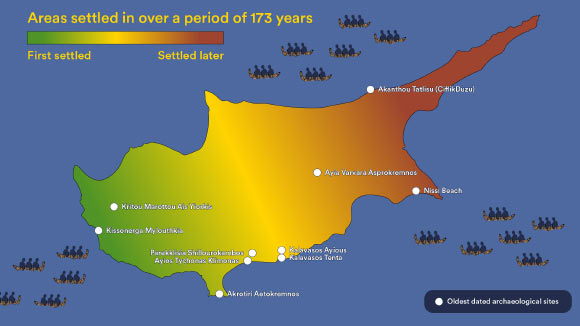Because of persisting narratives of isolation, inaccessibility, and unattractiveness, the initial peopling of one of the eastern Mediterranean islands is commonly regarded as a Neolithic phenomenon, initiated by farming populations from the mainland following demographic pressures. New research led by Flinders University’s Professor Corey Bradshaw shows instead that Cyprus could have been permanently peopled by hunter-gatherer populations by around 14,000 to 13,000 years ago, earlier than previously accepted; this process must have involved few, large migration events (100s to 1,000s of people) that infer the intent and organization of these early humans.
Using the latest archaeological data, hindcasted climate projections, and age-structured demographic models, Bradshaw et al. demonstrate evidence for early arrival (14,257 to 13,182 years ago) to Cyprus and predicted that large groups of people (1,000 to 1,375) arrived in 2 to 3 main events occurring within less than 100 years to ensure low extinction risk. Image credit: Bradshaw et al., doi: 10.1073/pnas.2318293121.
In examining the timing of the first human occupation of Cyprus, Professor Bradshaw and colleagues found that large islands in the Mediterranean Sea were attractive and favorable destinations for Paleolithic peoples.
Their findings refute previous studies that suggested Mediterranean islands would have been unreachable and inhospitable for Pleistocene hunter-gatherer societies.
The archaeologists used archaeological data, climate estimates, and demographic modeling to reveal the early peopling of Cyprus.
Their analysis of archaeological dating from the 10 oldest sites across Cyprus suggested first human occupation between 14,257 and 13,182 years ago, which is much earlier than previously thought.
“The island was then rapidly settled. Climate modeling indicated that this early peopling coincided with increases in temperature, precipitation, and environmental productivity sufficient to sustain large hunter-gatherer populations,” they said.
“Based on demographic modeling, we suggest that large groups of hundreds to thousands of people arrived on Cyprus in two to three main migration events in less than 100 years.”
“This settlement pattern implies organized planning and the use of advanced watercraft,” Professor Bradshaw said.
Within 300 years, or 11 generations, the population of Cyprus had expanded to a median of 4,000-5,000 people.
“The results demonstrate that, rather than being inhospitable, Cyprus and perhaps other Mediterranean islands would have been attractive destinations for Paleolithic hunter-gatherer societies,” said Dr. Theodora Moutsiou, an archaeologist at James Cook University and the University of Cyprus.
“It has been argued that human dispersal to and settlement of Cyprus and other eastern Mediterranean islands is attributed to demographic pressures on the mainland after abrupt climatic change saw coastal areas inundated by post-glacial sea-level rise, forcing farming populations to move to new areas out of necessity rather than choice.”
“This interpretation came as a consequence of major gaps in the archaeological record of Cyprus, deriving from differential preservation of archaeological material, preservation biases, uncertainties associated with dating, and limited DNA evidence,” said Dr. Christian Reepmeyer, an archaeologist at the Australian Research Council Centre of Excellence for Australian Biodiversity and Heritage, German Archaeological Institute and James Cook University.
“Our research, based on more archaeological evidence and advanced modeling techniques, changes that.”
“The new research results highlight a need to revisit questions of early human migration in the Mediterranean and test the validity of perceived early settlement dates in light of new technologies, field methods, and data,” Professor Bradshaw said.
The research is described in a paper published in the Proceedings of the National Academy of Sciences.
_____
Corey J.A. Bradshaw et al. 2024. Demographic models predict end-Pleistocene arrival and rapid expansion of pre-agropastoralist humans in Cyprus. PNAS 121 (21): e2318293121; doi: 10.1073/pnas.2318293121
>>> Read full article>>>
Copyright for syndicated content belongs to the linked Source : Breaking Science News – https://www.sci.news/archaeology/cyprus-human-arrival-12946.html
